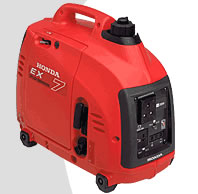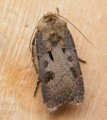Updated 01 Jun 2011
|
Moths caught at Bear Mead
|
|
Moths caught at Bear Mead |
Robinson moth trap
 |
A 600 watt 230volt generator was used,
driving a Mercury vapour lamp in a Robinson Moth Trap.
The trap was placed in position and turned on at 2100 hours on
27 May 2011, located in the centre of a young oak plantation with
foot-high grass. Weather was overcast, cool and windy, but no rain.
The generator ran out of fuel around 0200 hours, and was found empty
in the morning. The catch of moths was taken to BioBlitz HQ at
Corfe Mullen village Hall, and moths identified by Bob Steedman
on 28 May. The low catch was attributed to the cold and time of year.
**Photo copyright of Bob Steedman 2011
|
|
600 watt Generator
 |
01.Common Swift.
Korscheltellus lupulina
 |
02. ---
Celypha lacunna
 |
03. Cinnabar**.
Tyria jacobaeae
 |
04. Clouded border**.
Lomaspillis marginata
 |
06. White Ermine.
Spilosoma lubricipeda

|
07. Heart and Dart.**
Agrotis exclamationis

|
08. Light brown apple.**
Epiphyas postvittana

|
09. Marbled minor**.
Oligia strigilis

|
10. Middle-barred minor.
Oligia fasciuncula

|
11. ---**
Nematopogon swammerdamella

|
12. ---
Psuedargyrotoza conwagana

|
13. Shoulder-striped
wainscot**.
Mythimna comma
 |
14. Timothy tortrix**
Aphelia paleana

|
15. Treble lines**
Charanyca trigrammica

|
Hints and Tips.
- The majority of adult moths are nectar feeders, so site your trap in
areas full of native plants. Make your garden into a wildlife haven and
you’ll hopefully see a big increase in moth numbers. You may have to
accept increased damage to your plants as you should avoid the use of
pesticides.
- Improve the attractiveness of your garden by using plants that release
their strongest scent during the evening, such as nicotinia and night-scented
stock or honeysuckle.
- Cold, clear nights (especially following a period of milder weather)
will reduce the numbers of moths available for trapping. Cloudy, warm
nights are best, especially as it tends to be darker on cloudy nights and
so less light pollution will be competing with the trap light.
- Avoid trapping on bright nights with a full moon or near other sources
of light, e.g. street lamps.
- Avoid windy or wet nights as moths are less inclined to fly and to
avoid damage to the trap.
- If air masses are moving up from the South, southern coastal areas of
the UK may see increased numbers of migrants being blown over from the
continent.
- Peak mothing months are July and August. However, moths may be seen
in substantial numbers at other times of the year, especially in rural areas.
[From
NHBS]
|
Compiled, formatted, hyperlinked, encoded,
and copyright © 2011, John Palmer,  All Rights Reserved. All Rights Reserved.
|
